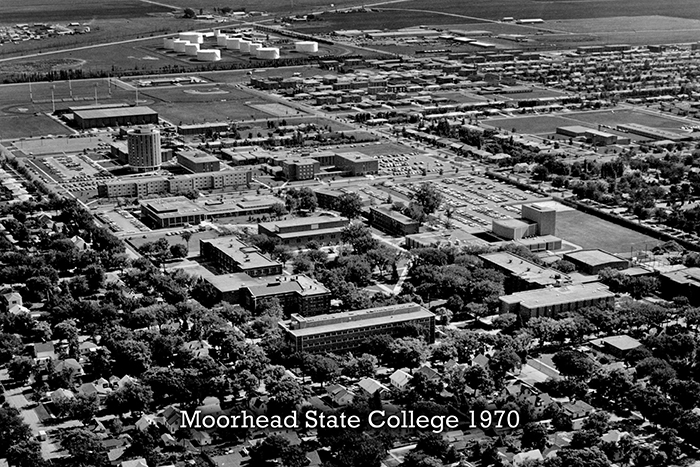Minnesota State University Moorhead's History
MSUM acknowledges that it occupies the ancestral land of the Anishinaabe Ojibwe, Dakota Sisseton/ Wahpeton and Yanktonai Dakota First Nations. With respect, we honor the elders, past and present, who have stewarded this land through generations. We acknowledge that we are on these traditional lands as a demonstration of our respect and understanding of where we are. We will strive to build towards a better relationship between our university and the indigenous people still present with us today.
Moorhead became the site for a new normal school in Northwestern Minnesota after State Senator Solomon Comstock introduced a bill to the Minnesota State Legislature in 1885, declaring "…it would be a fine thing for the Red River Country and especially for Moorhead."
Comstock then donated six acres of land and the next session of the Legislature appropriated $60,000 for the construction of Main Hall, which included classrooms, administrative offices and a library. When The Moorhead Normal School opened in the fall of 1888, President Livingston Lord presided over five faculty members and a class of 29 students. Classes offered: science, music, history, algebra, Latin, English and literature. Expenses were $5,000; President Lord’s salary was $2,500; faculty salaries were $800. Tuition was free to all students promising to teach two years in Minnesota. At the time, the campus towered on the outskirts of the city. Charles Loring, later Chief Justice of the State Supreme Court, rode his pony five miles each day to his classes.
The school’s first graduating class of eight students received their degrees in 1890. Old Main expanded in 1908 to provide space for a gymnasium and model school for student teaching. Twelve more acres were purchased for the school’s expansion, which included Weld and Comstock Halls, completing the "great circle" now known as the mall. In 1921, the need for high school teachers led the state legislature to authorize to award bachelor’s degrees, renaming the school Moorhead State Teachers College.

During the Depression, on Feb. 9, 1930, Old Main Hall burned. Student records were destroyed, 25,000 books turned to ashes and a stark shell was all that remained. But classes resumed the next week in Weld Hall, the dormitory and the Moorhead Armory.
By 1932 a new administration building named in honor of President Ray MacLean was opened with a model school and a gymnasium. From the ashes arose the "birth of the greater Moorhead State Teachers College," and a new symbol for the campus, the fire-breathing Dragon. Enrollment was 652 students.

During WWII, President O.W. Snarr announced that the college had entered into a contract with the Army Air Corps to train aviation students. From March 1943 to June 1944, 1,650 aircrew men were trained at MSTC. With the end of the War, enrollment swelled to more than 700 students and the school diversified and broadened into both a liberal arts and professional curriculum. Because of that diversity, the institutions name was changed to Moorhead State College in 1957.
A vast building program began under President John Neumaier from 1958 to 1968, adding 11 new buildings to campus and by the end of his term, 5,000 students were enrolled in classes here. In 1968, newly sworn-in President Roland Dille initiated Project E-Quality (now minority student affairs), making the college one of the first in the region to actively seek minority students. The next year, Moorhead State joined a cooperative cross-registration exchange with neighboring Concordia College and North Dakota State University, creating Tri-College University. By 1975, the choice of programs and majors jumped to 90. So the legislature that year permitted the institution to change its name to Moorhead State University.

In 1990, Moorhead State University’s enrollment reached a record 9,151 and the school’s most popular majors became elementary education, business administration, mass communications and accounting. President Roland Dille, the longest serving president in the history of Moorhead State (who oversaw the additions of Owens Hall, Nemzek Fieldhouse and Livingston Lord Library and the Center for Business to the campus), retired in 1994 after 26 years at the helm. He was succeeded in 1994 by Dr. Roland Barden, a McGregor, N.D., native with a PhD. in biochemistry.
Over the next 14 years Pres. Barden led the university in its conversion from quarters to semesters (1995) and was at the helm when Moorhead State University changed its name to Minnesota State University Moorhead (2000) and became one of the first campuses in Minnesota to go smoke free (2008). During his tenure MSUM also took on some major construction projects, including the new John Neumaier Apartments (2002), the new Science Lab Building (Now Langseth Hall - 2004) and the new Dragon Wellness Center (groundbreaking in 2007) as well as major renovations to Hagen and MacLean Halls.
Pres. Barden retired in the summer of 2008.
On July 1, 2008, Edna Szymanski, became the 10th and first woman president of MSUM. She had previously served as senior vice president for academic affairs and provost at the University of Maine, Orono.
She took over the presidency as the national economy was headed into recession, legislative support was insufficient, fewer high school graduates were in the student pool, and the community was anticipating major Red River flooding. The challenges were many.
Under her leadership, the university strengthened its focus on educational excellence, maintaining access for students from all backgrounds and alignment of programs of study with regional workforce needs. Szymanski’s tenure included challenges with budget cuts and major floods, as well as accomplishments such as incorporating established business principles for fiscal sustainability and a strategic planning process that focuses the university’s future on student success.
Edna Szymanski retired on June 30, 2014.
A familiar face emerged to take over Szymanski’s post—MSU Moorhead Provost and Vice President of Academic Affairs Anne Blackhurst became the 11th president of the university on July 1, 2014, and inaugurated September 26, 2014.
During Blackhurst’s presidency, she provided strong leadership and navigated through some challenging times, including the pandemic. During her tenure, Blackhurst led the university through the development of a strategic framework, articulating MSUM’s purpose, mission, core values and strategic anchors, guided the university through an intensive review of the academic programming, and directed an expansion in graduate programs and enrollments, including launching MSUM’s first doctoral program – the Ed.D. in Educational Leadership. Under her stewardship, MSUM completed a $60 million-dollar capital campaign and led the efforts to redesign the university’s facilities.
Under her leadership, MSUM increased student access by being one of the first Minnesota State universities to eliminate the ACT admission requirement and investing more than $1 million to improve scholarships. Vital community partnerships emerged with Essentia Health to create The Essentia Health Center for Nursing, and with Forum Communications to create The Marcil Center for Innovative Journalism.
Dr. Anne Blackhurst, or President Anne as she was known on campus, retired June 30, 2023, leaving behind a lasting legacy.
On July 1, 2023, Dr. Timothy Downs became MSUM’s 12th president. President Downs is well-equipped to lead MSUM, having served as president/CEO of Northern State (Aberdeen, S.D.) University from 2016 to 2021. Before joining MSU Moorhead, he was interim chief of staff at Cal Poly Humboldt (Arcata, Calif.,) where he coordinated efforts among all divisions within the university.
Downs is a leader known for facilitating transformational change and positioning campuses to meet current and future demands and needs. In past roles, he has dedicated himself to student success and sustaining a campus culture that facilitates a spirit of belonging. Bringing enrollment management skills and strong financial understanding, he is an accomplished fundraiser who has cultivated a shared vision with stakeholders and investors.
